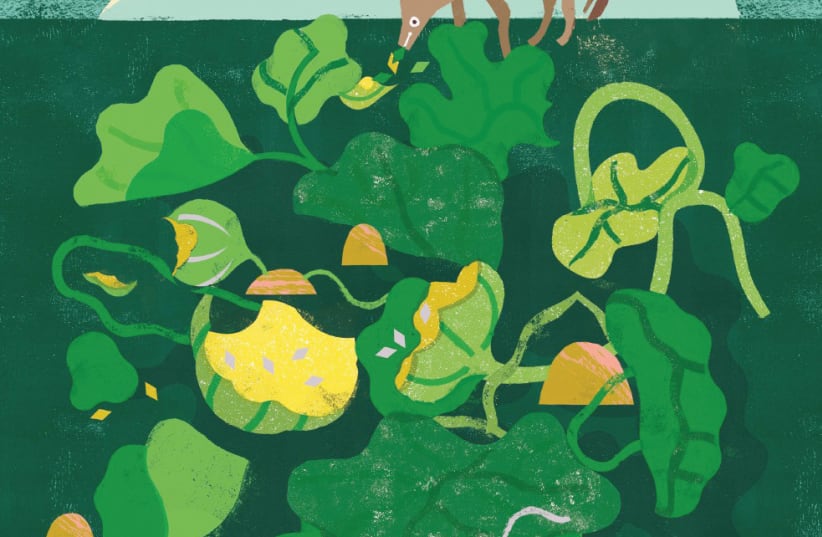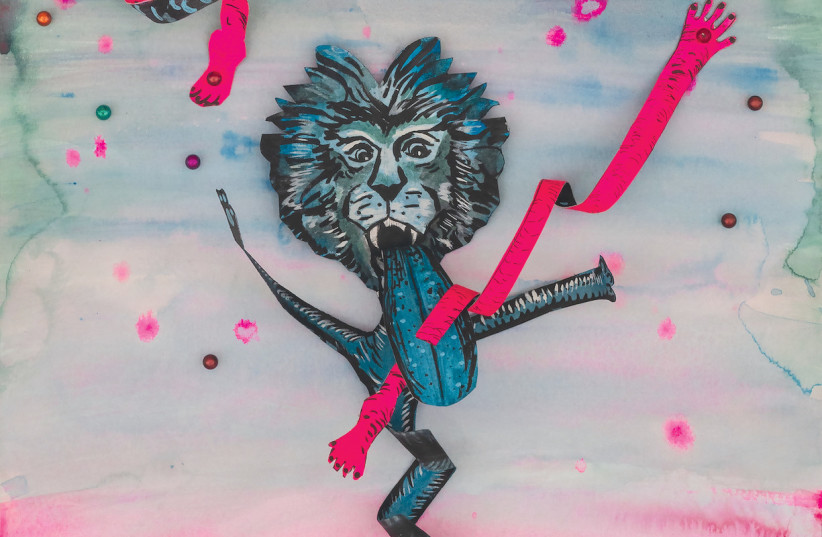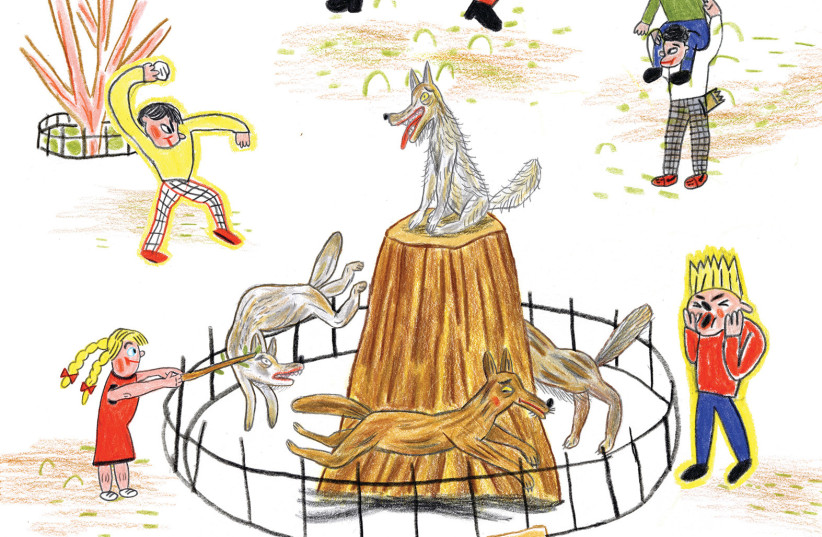Coming up with such an evocative thematic moniker for this year’s edition of the Outline Festival is something of a stroke of genius.
Jerusalem’s annual illustration-based event has gained credence, among artists and the public alike, over the past five years, unfurling works that reflect not only the chosen topic but also some of the undercurrents of the city’s fascinating and checkered human, cultural and sociopolitical history. Hence, opting for the theme of “Layers” for this year’s run out – scheduled for August 5 to 12 – is both a cool move and a natural one.
Perennial artistic director Noa Kelner certainly goes along with that line of thought.
“Jerusalem is a city full of layers,” she notes, “historical and human layers, and infinite strata, open and concealed, meet along the city’s main artery, Jaffa Road.”
That is a geographic curatorial ploy that has served the festival programming well over the years, particularly in view of the pandemic constraints on freedom of movement and assembly that impacted the 2020 installment. Then, works were displayed in the great urban outdoors, at Light Railway stops and other convenient junctures around the city.
That will be the case this year too, with linearly defined images of all kinds, styles and subject matter placed at vantage points along the thoroughfare, and in spots located just behind the street facades. One such is the Saidoff Tower precinct, which will host a clutch of illustrations by Assaf Ben Harroch, who is probably better known for the innovative animation creations he puts out as a partner in Studio Poink.
“Actually, I am fundamentally an illustrator, and I bring that into my work as an animator,” he sets me right. “There are a lot of very good illustrators in Israel. When we opened our studio there was a lot of computerized animation being done here.”
Ben Harroch and his colleagues thought a more illustration-oriented approach to the filmic discipline was in order.
In addition to exhibiting illustrations, Ben Harroch will also present a delightful thought-provoking short animated work called Regeneration on August 8 at Muslala on the top level of the Clal Building, naturally, on Jaffa Road. For the illustrator-animator, the art-life-nature reciprocal synergistic relationship is a given, and he will follow the screening with a talk about efforts he has made over the past year to cultivate a vegetable patch at his kibbutz home, and to spread the good word about the across-the-board benefits to be gained from growing our own food. And, while they are at it, the members of the audience can get some idea of what the urban renewal Muslala venture is all about, by checking out the expansive rooftop – Hamirpeset (The Balcony) – and taking in the motley array of boxes and other receptacles with plants of all hues and shapes, chill-out areas, plant nursery and beehives. And there is an area where some curiously shaped structures are in the process of being built.
“This will be a sort of Airbnb facility,” explains Muslala manager Danny Kinreich. “We are also building showers and compost toilets.”
Naturally.
“I’d like people in the city to look up from street level and consider the possibilities roofs offer for growing things.”
Ben Harroch says growing your own veggies is a win-win situation for all involved.
“Since I started developing the vegetable patch I feel less anxious about things in general. It all began last fall, in the middle of the pandemic. Suddenly I had more time. I think my whole attitude, including to art, has changed. I enjoy working with my art more now.”
ALL TOLD, Outline comprises 14 group and solo exhibitions that offer a broad sweep of readings of the layers concept. It must be said, there are some pretty promising titles in there. The “15 Melodies to the Depths” exhibition is certainly high up in the thought-provoking appellation stakes. The show is due to be held at the New Spirit center, the sprawling building on Jaffa Road that housed Shaare Zedek Hospital between 1902 and 1980, and thereafter the IBA.
The name of the exhibition, it transpires, comes from deep within the Jewish scriptures subtext. Religious upbringing notwithstanding, curator Tamar Odenheimer, who also has a work on display at New Spirit, says she came across the dramatic tale by chance.
“We had a friend of my parents, a professor of Jewish Studies at the Hebrew University, over for Shabbat dinner, and she related the legend to us,” Odenheimer recalls. “She was very excited about it.”
The same went for the professor’s hosts.
According to the Talmudic story, King David, whom God prohibited from building the First Temple due to having “shed much blood,” decided he would dig the foundations regardless. However, it appears that he wasn’t exactly clued in on engineering requisites, and he dug down way too far, 16,000 cubits to be precise, which translates at over 7,000 meters. That’s a whopper of a pit, which set off an environmental problem, as the groundwater began to rise from the nether parts of the dig and threatened to flood the region.
The legend has it that King David, a skilled musician, set about redressing the damage by playing 15 melodies – set to the words of the 15 Psalms that begin with the words shir lamaalot (a song of ascents) – and coaxing the bottom of the pit back up to a manageable, non-life threatening depth, thereby keeping the groundwater in its place. He also wrote the explicit name of God on a piece of paper and cast it into the excavation.
“There is definitely an environmental message here,” says Kelner. “Just look at the flooding in places like Germany recently. That has to give us food for thought.”
That comes into the curatorial reckoning too.
“The way we put up the works is also important,” notes Odenheimer. “We will hang them from the ceiling, like mobiles. The impression that generates is central to the exhibition. I wanted the exhibits to simulate actual reality.”
For Odenheimer, being able to view an image from 360 degrees suits that take on the art-life balancing act. The curator also notes a work by Yam Matarasso that directly references petroleum and gas.
“We have to think about these substances which we extract from the ground,” she says. “It is important to convey that, and the green message in general.”
The thinking behind the presentational format also took into account King David’s vantage point when he realized the enormity of his calculation blunder.
“When you look at the illustrations hanging from the ceiling, you take a vertical view of them, which I think helps to tell the story behind all of this. The idea is also for all of the parts to make up one single body of work, including the spaces between them.”
THERE IS certainly a tale behind the Jerusalemite Petting Zoo exhibition, which will be on view in the windows of the Azrieli Gallery on the Hadassah Academic College campus, on Haneviim Street.
“That was where the first zoo in Jerusalem was established, on the corner with Harav Kook Street, in the 1950s,” explains curator Tali Kayam. “It was founded by Prof. Aaron Shulov, initially as an animal petting corner.”
Shulov was one of the first students of the Hebrew University and became an acclaimed professor of entomology. There is a neat local familial twist here. His granddaughter, Lee He Shulov, is the long-serving director of the Art Cube Artists’ Studios in Talpiot, and a respected artist in her own right.
Shulov Sr.’s idea was to set up a zoo in Jerusalem that housed as many animals mentioned in the Bible as possible.
The illustrations by seven artists, including Teddy Goldenberg who, like Ben Harroch spreads his talents across the illustration and animation fields, Dan Allon, Nimrod Sehayek, Avital Manor, Guy Nissenhaus and Shiraz Fuman, not only feed off life at the zoo, but also off the animal sanctuary’s checkered history. The latter is portrayed in newspaper articles, published over the years, which were sourced by the exhibition researcher Tal Schwartz.
When I mentioned my reticence over the idea of zoos, and the imprisonment of animals for the public’s viewing pleasure, Kayam surprisingly supports my viewpoint.
“You are quite right,” she says. “Some of the articles that will appear alongside the illustrations talk about the moral challenges and technical failures that cost lives, both of animals and staff members.”
The founder, it seems, also had his question marks about the enterprise.
“In his memoirs, Prof. Shulov writes a lot about the incompatibility between the encounter between the animals and the public. There was a case in which a child was bitten by an animal and Shulov was fined by the court. People may have seen them as aggressive animals, but they weren’t household pets, they were wild animals and shouldn’t have been behind bars.”
Kayam says that fateful dissonance resonates in the exhibitors’ work.
“Usually, illustration – like a zoo – has this image of something for the whole family, something colorful and comic, something that is meant to be entertaining. But, all the illustrations address highly complex situations. There is a sort of ars poetica situation here. All the articles have a dark side to them.”
Something else for us to mull over while we make our way across from one Outline showing to the next, around town.
And there will be plenty to see over the weeklong event. One exhibition, in particular, will address the ongoing evolution of the city and how its various layers are in a constant state of flux. The New Spirit building, which will house several shows as well as a concert on the opening evening by singer/songwriter Rona Kenan, will host the Binyan Hitpael exhibition, curated by Avital Wexler, which focuses on the meandering history of several Jerusalem landmark edifices.
“This really looks at the layers of Jerusalem,” Kelner explains. “Each artist takes one building in the city that changed its purpose in an artistic direction, such as Alliance House.”
The said structure is a relevant case in point. It started out life in 1882 as one of the French-leaning education Alliance School network. Thereafter it served as an orphanage, and as the base for a number of schools and, five years ago, various arts facilities moved in, including plastic arts, dance and music schools, which operated under the New Spirit banner.
Which brings us back, neatly, to the Binyan Hitpael showing. The Hebrew title translates into various meanings, one of which infers a transformation continuum.
Other standout offerings include the Miyad Leyad (Hand Me Down) exhibition, which is based on imagined correspondence between figures from the art world, and feeds off music as a source of inspiration for the visual arts.
There will also be guided tours, online events, workshops, live music and the official launch of the Miyad Leyad magazine. Many of the events are free. Copies of Miyad Leyad and some of the illustration exhibits will be on sale at the 24/9 arts and crafts store at 9 Shlomo Hamelech Street.
For more information: outlinejerusalem.com/



